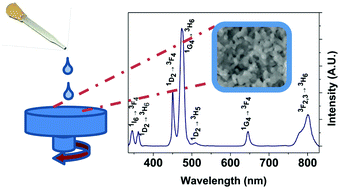Novel sol–gel fabrication of Yb3+/Tm3+ co-doped β-NaYF4 thin films and investigation of their upconversion properties†
Abstract
An innovative sol–gel process, using a mixture of Na(hfa)·tetraglyme and RE(hfa)3·diglyme (RE = Y, Yb, Tm) complexes, has been optimized to produce upconverting β-NaYF4:Yb3+/Tm3+ thin films. The X-ray diffraction (XRD) analysis confirms that the new sol–gel preparation route yields reproducibly and selectively the hexagonal Na(Y1.5Na0.5)F6 structure (β-NaYF4) without any impurity phases, since no peaks of the cubic NaYF4, YOF, Y2O3 or NaF phases were observed. This final goal has been achieved through an accurate optimization of the operative parameters such as the molar ratio of the precursor mixture, the aging time of the sol, the spin coating procedure and the annealing temperature. Field-emission scanning electron microscopy (FE-SEM) images indicate that the morphology of the surfaces, grain dimensions and thickness are strongly related to the processing parameters, with the hexagonal phase films having a very uniform morphology. Energy dispersive X-ray (EDX) analyses established the film composition in terms of dopant ions, which are responsible for the upconverting properties of the material. Luminescence measurements under laser excitation at 980 nm confirmed the promising upconversion properties of the β-NaYF4:Yb3+/Tm3+ films.



 Please wait while we load your content...
Please wait while we load your content...